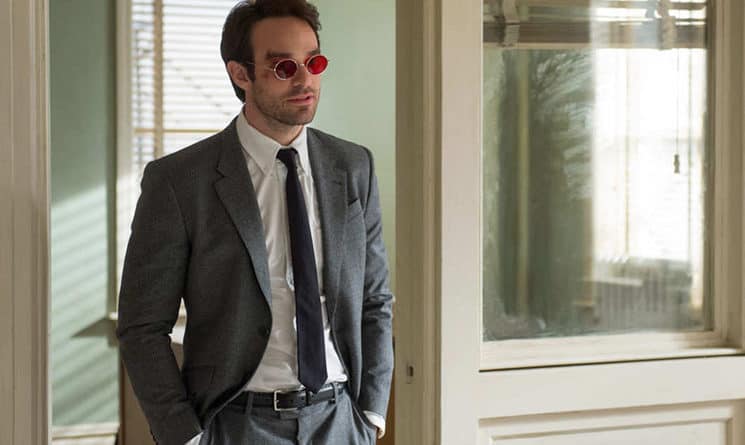Netflix continues to keep its ever-growing number of subscribers excited and engaged with its eclectic, ready-to-binge offerings. High-caliber talent, short seasons, and genre unpredictability are the streaming service’s calling cards. But even the most plugged-in Hollywood insider couldn’t have guessed the next jewel in Netflix’s crown: “Marvel’s Daredevil,” a violent, gritty legal thriller that reboots a failed B-list superhero film franchise.
Even I was skeptical. I’ve read a lot of Daredevil comic books. I like to binge-watch TV. But my initial reaction leading up to “Marvel’s Daredevil” was muted optimism at best. That I, Netflix’s target audience, wasn’t salivating over the adventures of Matt Murdock, blind lawyer by day/ninja vigilante superhero by night, worried me.
But now that I’ve devoured the 13-episode first season? Wow. The blood. The action. The casting. The costuming. The near-perfection. Near, because while this small-screen saga of Hell’s Kitchen is so much better than I expected, it wasn’t entirely free of creative missteps.
What they did right has changed the conversation about TV, though. This month, audiences were expected to obsess about the return of “Game of Thrones” and the final episodes of “Mad Men.” Instead, social media has been lit up over a second-string Marvel Comics character. When “Daredevil” debuted on the page in 1964, he was a warmed-over variation on Spider-Man, and when the character went through a renaissance in the 1980s, he had a dark, tragic Batman vibe. Daredevil isn’t iconic, but he is confusing — he’s had nervous breakdowns, secret identity troubles, and, for a while, was possessed by a demon. He isn’t the most audience-friendly hero, and distilling dozens of iterations and decades of stories was one of the many challenges facing the show.
Showrunner Drew Goddard, who previously worked on “Lost” and “Alias,” struck a perfect balance. The tortured vigilante Daredevil, riddled with Catholic guilt and daddy issues, isn’t compelling if we don’t see his alter-ego, Matt Murdock, a coy ladies’ man and lawyer. So Goddard gave us both, a move that makes Daredevil stand out among the heroes who already populate Marvel’s multimedia world.
Goddard’s second key decision, and one that’s instrumental to the success of “Marvel’s Daredevil,” is how Daredevil’s origin is handled. Once the most exciting part of a hero’s story, a decade of comic-book films have made origins boring. Instead of stalling the narrative momentum, Goddard sets up Daredevil’s devastating origin — young Murdock, raised by his single dad and boxer Jack (John Patrick Hayden), loses his sight when he pushes an elderly man out of the way of a truck full of radioactive waste — in just one beautifully shot scene.
Part of what makes “Daredevil” interesting is that it’s new territory for both Netflix and Marvel.
That expertly shot sequence is another win for “Daredevil.” It’s a great looking show, drowned in shadows, errant sparks, and wounds that never seem to fully heal. Director Phil Abraham marries these images to Goddard’s first two scripts. Abraham cut his teeth on nearly 50 episodes of “The Sopranos” before jumping to AMC and getting behind the camera for episodes of “Breaking Bad” and “Mad Men.” His sophisticated eye weaves a complicated tapestry — “Daredevil” is a legal drama and a superhero action showcase with threads of paranoid conspiracy thrillers, mob shows, and some much-needed comic relief. In lesser hands, it would have easily unraveled. Abraham’s direction at the conclusion of the second episode, “Cut Man,” is one of the most unique, breathtaking sequences I’ve seen on television or film.
The talent in front of the camera is just as capable. Charlie Cox (“Boardwalk Empire”) stars as the grown-up Murdock, and he could carry the show on his own. Vulnerable, confident, terrified, and terrifying — any can be difficult to play on their own, but Cox often plays them all within the same scene. As Murdock’s law partner Foggy Nelson, Elden Henson finds the perfect balance of comic timing and honest emotion that a longtime friendship would create. Deborah Ann Woll (“True Blood”) plays Karen Page, who’s initially introduced as a helpless victim but who soon becomes the show’s backbone.
And then there’s the show’s villain: Vincent D’Onofrio as Wilson Fisk, the city’s Kingpin of Crime, with whom both Daredevil and Murdock duel during this first season. D’Onofrio is an acquired taste, and his somewhat mechanical, mannered performances in the past have turned me off. But I’m telling you this: as Fisk, D’Onofrio scared the sassafras out of me. His razor-sharp oscillations between rage, love, and loyalty are incredible. At times, he threatens to steal the show from Cox.
The supporting cast is not handled as well as the leads. While Rosario Dawson is note perfect as Murdock’s confidant/love interest Claire Temple, she disappears from the show for such long stretches that it’s jarring when she returns. There are not enough superlatives to describe Scott Glenn as Stick, Murdock’s mentor who teaches him at an early age to harness his heightened senses. However, the writers saddle him with so many mystical red herrings (presumably setup for Netflix’s upcoming “Iron Fist” series) that this excellently flawed idol seems ultimately wasted.
Part of what makes “Daredevil” interesting is that it’s new territory for both Netflix and Marvel. Though the streaming service has an impressive roster of original programming, it’s still relatively new to the game. And though Marvel has had success with two TV shows (“Agents of S.H.I.E.L.D.” and “Agent Carter” on ABC), “Daredevil” is its first produced without a big studio backing it. There were plenty of ways for “Daredevil” to fail, but it doesn’t. Visceral, smart, and action-packed, “Daredevil” is a hit, and with any luck, Marvel and Netflix will keep those hits coming.

